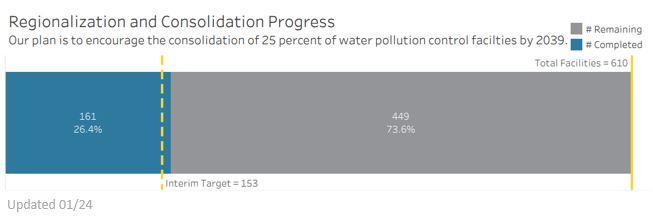Communities throughout the country often face significant challenges in providing wastewater services at a reasonable cost to users while complying with federal and state regulations. These challenges include aging infrastructure, limited technical and administrative capabilities, and increasing costs while maintaining a low user rate base. The state of Missouri is no exception to these challenges. While many options exist to address these challenges, the Missouri Department of Natural Resources found that regionalization and consolidation (R&C) can be a cost-effective and successful approach for assisting communities with their wastewater service challenges.
For example, some small systems struggling to manage their operations may find that sharing, or even transferring responsibility for the system is the best way to ensure that it is well-operated and provides proper service to its customers. One way to effectively address these challenges is to partner with one or more other treatment systems. A mutually beneficial partnership can be as simple and informal as two or more wastewater systems agreeing to share equipment or buy treatment chemicals together to save money. A more formal partnership could include a contract to share operators and/or build an emergency interconnection. The systems may pursue regionalization, as outlined below, or consider selling the utility, which is called consolidation.
Regionalization
Regionalization involves sharing physical infrastructure in a defined geographic area when a political or private entity provides wastewater service by means of physically connecting existing and future communities to a regional or central plan. Examples of regionalization include a sewer district connecting the flows of three privately owned treatment facilities to a centralized facility and a municipality connecting several small facilities by extending a sewer line. Reduced user rates and operational costs are two of the benefits achieved when multiple entities work together.
When multiple entities work together, each utility often benefits from reduced capital and operational costs, and increased economies of scale. If there is already a larger wastewater system in your area, like a city or sewer district, you may wish to consider contracting with and connecting to their system. Many municipalities and regional districts have extra capacity and may be willing to contract with a smaller entity, whether public or private, to accept and treat its wastewater. If you believe regionalization is an available option for your system, we recommend contacting providers that operate in your area.
Consolidation
Consolidation is the centralized ownership of multiple facilities. Typically, this involves the sale of a small, independent facility to a specialized wastewater operating company. The clear advantage with consolidation is a decrease in costs to users – simply stated, there are more customers to share the burden of paying the bills. Small wastewater system owners are able to relinquish the burden of costs, regulatory obligations and requirements associated with the wastewater system. Consolidation often achieves higher levels of operating performance and rates of regulatory compliance, which not only benefits customers but benefits the community’s local water quality as well.
Financial Incentives
When systems consolidate or regionalize, they increase their financial capacity, and may be eligible to apply for financial assistance programs such as the State Revolving Fund (SRF) loans. The department’s Financial Assistance Center administers Missouri’s Clean Water SRF, which provides low-interest loans for wastewater treatment, sewer rehabilitation and stormwater quality improvements.
The department also offers Engineering Report Services Grants (ESRG), for which eligible systems are awarded funding to explore options for regionalization, consolidation, or unification.
Additionally, since 2019, the department began offering the Clean Water SRF Regionalization Incentive Grant. This grant is available to qualifying municipalities in Missouri and is intended to incentivize connections that reduce the number of small, struggling facilities. If approved, the grant will fund 100% of all eligible costs for the project, including planning, designing, and constructing the sewer connection!
Learn more about financial opportunities at the department’s Financial Assistance Center.
Progress
The department officially launched a Regionalization and Consolidation Initiative to promote and support the permitted wastewater community develop more efficient, resilient and sustainable wastewater infrastructure across the state. The initiative's overarching goal is to impact 25% of wastewater facilities through regionalization, consolidation and other applicable terminations over a 20-year timeline. In January 2019 at the time of inception, 2,442 domestic permitted facilities existed across the state. The department's final target is to impact 610 permitted facilities by January 2039.
The Water Pollution Control Branch tracks progress toward this goal on a monthly basis, but our quarterly updated progress bar is shown below.
Explore Our Map
MAPitT is a map of all domestic wastewater facilities permitted with the department. You can use the special features of this map to search for and highlight any permitted facility within any designated radius of your system or other point of interest. With this, you can view basic information of neighboring systems, their permit, and public contact information to inquire about potential regionalization or consolidation partnerships.

